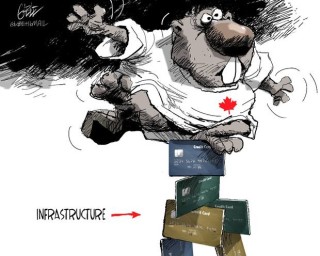The worsening price rout in commodities is hitting home far beyond the oil patch, darkening the mood of Canadian consumers, businesses and investors.
As the price of crude slumped to near $31 (U.S.) on Monday, two new confidence surveys suggest the main drivers of the economy – consumers and businesses – may be stalling. That points to weaker spending and hiring this year.
In spite of optimism from the Liberal government, the glum mood was on full display in financial markets on Monday. The Standard & Poor’s/TSX composite – already 20 per cent off its 2014 high – lost more ground, falling 1 per cent to 12,319.25. Meanwhile, the oil industry took another hit when the B.C. government said it has not been given enough information to allow it to support the expansion of Kinder Morgan’s Trans Mountain pipeline.
The growing pessimism is rekindling concerns about anemic growth, or worse, outright recession. The situation is ratcheting up pressure on Bank of Canada Governor Stephen Poloz to provide more interest rate relief, perhaps as early as next week’s scheduled rate announcement, as well as more fiscal stimulus from the new Liberal government in Ottawa.
On Monday, a closely watched Bank of Canada quarterly survey of businesses across the country showed that hiring and spending plans are weaker than they have been since 2009. The Conference Board of Canada also released its consumer confidence index for December, which fell sharply.
Finance Minister Bill Morneau insisted the answer is to follow through on Liberal campaign promises, including middle-class tax cuts, enhanced child benefit payments to parents and $60-billion in additional infrastructure spending over the next 10 years.
“We do believe that these measures, taken together, will make an important difference on growth in this country, and we believe that they will enable Canadian companies and organizations to be confident enough to invest,” he told reporters after delivering a luncheon speech in Halifax. “I’m confident and I’m optimistic that these will make a difference and they will help our economy significantly. We do intend on trying to both invest over the long term and stimulate over the shorter term.”
Many economists are not so sure as they anxiously wait to see if Mr. Poloz will cut interest rates.
The spreading fallout from the price drop in commodities beyond the oil patch, including coal and copper, “raises clear concerns about the growth outlook,” agreed Paul Ferley, assistant chief economist at the Royal Bank of Canada. But he said the economy can still reach the Bank of Canada’s current forecast of 2 per cent growth this year if Canadian exporters outside the resource sector seize the opportunity to exploit the cheaper dollar by boosting their international sales.
Others fear the 2 per cent forecast is far too rosy. Waning business confidence “suggests the economy is slipping back into recession,” warned economist David Madani of Capital Economics.
“The [business] survey provides more evidence that the economy isn’t coping well with the worsening commodity price shock,” Mr. Madani said. “More policy stimulus will be desperately needed, both monetary and fiscal.”
The deteriorating environment could even prompt Canada’s central bank to cut its already low benchmark interest rate for the third time in a year on Jan. 20 at its next rate-setting meeting, according to Merrill Lynch. “Economic weakness is spreading beyond energy, affecting manufacturing as well,” Merrill Lynch said in a research report, adding that the Bank of Canada will be forced to cut its 2016 growth forecast to 1.5 per cent from 2 per cent.
That view that a rate cut is imminent remains the minority. Most Bank of Canada analysts expect the key rate to stay at 0.5 per cent next week.
The Bank of Canada’s closely watched quarterly business outlook survey shows hiring and investment plans at their lowest levels since the aftermath of the 2009 recession.
“The negative effects of the oil price shock are increasingly spreading beyond the energy-producing regions and sectors,” the bank said in the survey. It said weak commodity prices “pose significant challenges for many businesses.”
The survey results mirror the Conference Board of Canada’s monthly index of consumer confidence, also released on Monday, which fell to its lowest level in two years in December. The index, which dropped 12 points to 91 points, finds Canadians increasingly fretful about their finances and job prospects, and reluctant to make major purchases.
In a speech last week, Mr. Poloz called the commodities price rout a “seismic shift” that could last up to five years and drain $50-billion a year from the Canadian economy.
A roughly equal number of respondents in the central bank’s survey reported higher and lower sales in the past 12 months. A slight majority of companies anticipate higher sales in the year ahead.
The one bright spot in the business outlook comes from exporters who are not connected to the resource sector. These companies, particularly manufacturers, report that they are benefiting from strengthening demand, and expect to do even better as the U.S. economy recovers.
“Exporters not linked to commodity production anticipate significantly stronger sales growth than other firms,” the bank pointed out. “The divergence between foreign and domestic demand was highlighted by firms in most regions.”
The cheaper dollar is helping tourist businesses. And while most companies face higher costs because of the weak dollar, some are coping by switching to Canadian suppliers. A few are even planning to bring production back to Canada, the bank said.
The business outlook survey and the consumer confidence survey were conducted in late November and early December, before the latest declines in stocks, the price of crude and the dollar.
BARRIE MCKENNA AND BILL CURRY
OTTAWA — The Globe and Mail
Published Monday, Jan. 11, 2016 10:37AM EST
Last updated Tuesday, Jan. 12, 2016 4:16AM EST

